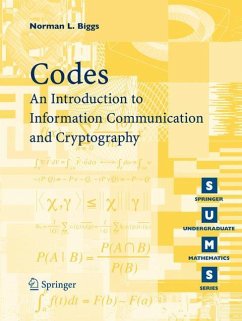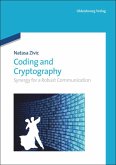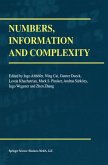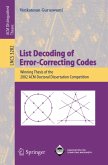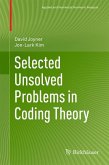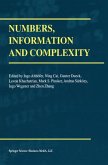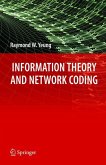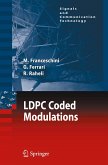This book is an integrated introduction to the mathematics of coding, that is, replacing information expressed in symbols, such as a natural language or a sequence of bits, by another message using (possibly) different symbols. There are three main reasons for doing this: economy, reliability, and security, and each is covered in detail. Only a modest mathematical background is assumed, the mathematical theory being introduced at a level that enables the basic problems to be stated carefully, but without unnecessary abstraction. Other features include: clear and careful exposition of fundamental concepts, including optimal coding, data compression, and public-key cryptography; concise but complete proofs of results; coverage of recent advances of practical interest, for example in encryption standards, authentication schemes, and elliptic curve cryptography; numerous examples and exercises, and a full solutions manual available to lecturers from www.springer.com.
Many people do not realise that mathematics provides the foundation for the devices we use to handle information in the modern world. Most of those who do know probably think that the parts of mathematics involvedare quite 'cl- sical', such as Fourier analysis and di?erential equations. In fact, a great deal of the mathematical background is part of what used to be called 'pure' ma- ematics, indicating that it was created in order to deal with problems that originated within mathematics itself. It has taken many years for mathema- cians to come to terms with this situation, and some of them are still not entirely happy about it. Thisbookisanintegratedintroductionto Coding.Bythis Imeanreplacing symbolic information, such as a sequence of bits or a message written in a naturallanguage,byanother messageusing (possibly) di?erentsymbols.There are three main reasons for doing this: Economy (data compression), Reliability (correction of errors), and Security (cryptography). I have triedto cover each of these three areas in su?cient depth so that the reader can grasp the basic problems and go on to more advanced study. The mathematical theory is introduced in a way that enables the basic problems to bestatedcarefully,butwithoutunnecessaryabstraction.Theprerequisites(sets andfunctions,matrices,?niteprobability)shouldbefamiliartoanyonewhohas taken a standard course in mathematical methods or discrete mathematics. A course in elementary abstract algebra and/or number theory would be helpful, but the book contains the essential facts, and readers without this background should be able to understand what is going on. vi Thereareafewplaceswherereferenceismadetocomputeralgebrasystems.
Many people do not realise that mathematics provides the foundation for the devices we use to handle information in the modern world. Most of those who do know probably think that the parts of mathematics involvedare quite 'cl- sical', such as Fourier analysis and di?erential equations. In fact, a great deal of the mathematical background is part of what used to be called 'pure' ma- ematics, indicating that it was created in order to deal with problems that originated within mathematics itself. It has taken many years for mathema- cians to come to terms with this situation, and some of them are still not entirely happy about it. Thisbookisanintegratedintroductionto Coding.Bythis Imeanreplacing symbolic information, such as a sequence of bits or a message written in a naturallanguage,byanother messageusing (possibly) di?erentsymbols.There are three main reasons for doing this: Economy (data compression), Reliability (correction of errors), and Security (cryptography). I have triedto cover each of these three areas in su?cient depth so that the reader can grasp the basic problems and go on to more advanced study. The mathematical theory is introduced in a way that enables the basic problems to bestatedcarefully,butwithoutunnecessaryabstraction.Theprerequisites(sets andfunctions,matrices,?niteprobability)shouldbefamiliartoanyonewhohas taken a standard course in mathematical methods or discrete mathematics. A course in elementary abstract algebra and/or number theory would be helpful, but the book contains the essential facts, and readers without this background should be able to understand what is going on. vi Thereareafewplaceswherereferenceismadetocomputeralgebrasystems.
From the reviews:
"This undergraduate textbook is a pleasure to read. ... The author has a sense of humor, and he is not afraid to use it. The examples are very well chosen. ... This very enjoyable book deserves many readers." (Miklós Bóna, The Mathematical Association of America, September, 2008)
"This is a clearly and carefully written introduction into information theory, coding theory and cryptography. ... Due to the many motivating explanation, the numerous number of examples (for nearly every definition, concept and result) ... and the many suggestions for further reading this book is, in my opinion, very suitable as well as for beginners in the field ... . I can very much recommend this book to interested bachelor students as well as to lecturers on this subject." (Ralph-Hardo Schulz, Zentralblatt MATH, Vol. 1148, 2008)
"Coding here refers to the formal transcription of abstract information with the aim of achieving some combination of efficiency, reliability, and perhaps security. ... Codes provides the student an initiation and shows the author's great talent for mathematical exposition clearly propelled by big ideas. ... will be valuable for academic libraries. Summing Up: Highly recommended. Advanced academic audiences, upper-division undergraduates through researchers/faculty." (D. V. Feldman, Choice, Vol. 46 (8), April, 2009)
"There are indeed substantial texts devoted to compression, coding systems of various sorts, and encryption. This text brings these three components together in a unified context and provides a basic, mathematically inclined introduction to each. ... There is a reasonable amount of worked examples and exercises in the text. ... This book could serve as a nice introduction to coding theory for computer science or electrical engineering students ... and for mathematics students interested in computing and applied mathematics." (Jeffrey Putnam, ACM Computing Reviews, September, 2009)
"This undergraduate textbook is a pleasure to read. ... The author has a sense of humor, and he is not afraid to use it. The examples are very well chosen. ... This very enjoyable book deserves many readers." (Miklós Bóna, The Mathematical Association of America, September, 2008)
"This is a clearly and carefully written introduction into information theory, coding theory and cryptography. ... Due to the many motivating explanation, the numerous number of examples (for nearly every definition, concept and result) ... and the many suggestions for further reading this book is, in my opinion, very suitable as well as for beginners in the field ... . I can very much recommend this book to interested bachelor students as well as to lecturers on this subject." (Ralph-Hardo Schulz, Zentralblatt MATH, Vol. 1148, 2008)
"Coding here refers to the formal transcription of abstract information with the aim of achieving some combination of efficiency, reliability, and perhaps security. ... Codes provides the student an initiation and shows the author's great talent for mathematical exposition clearly propelled by big ideas. ... will be valuable for academic libraries. Summing Up: Highly recommended. Advanced academic audiences, upper-division undergraduates through researchers/faculty." (D. V. Feldman, Choice, Vol. 46 (8), April, 2009)
"There are indeed substantial texts devoted to compression, coding systems of various sorts, and encryption. This text brings these three components together in a unified context and provides a basic, mathematically inclined introduction to each. ... There is a reasonable amount of worked examples and exercises in the text. ... This book could serve as a nice introduction to coding theory for computer science or electrical engineering students ... and for mathematics students interested in computing and applied mathematics." (Jeffrey Putnam, ACM Computing Reviews, September, 2009)

